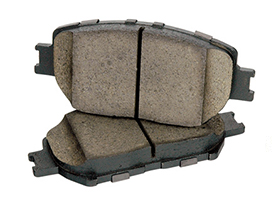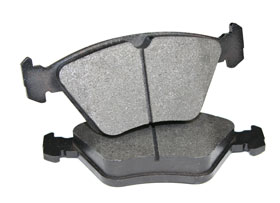Choosing the Best Brake Pads for your vehicle: Organic vs Ceramic vs Semi-Metallic
The main thing to remember is that brakes pads suited for a specific situation may actually perform very poorly in another situation. Every driver has a different style of driving and they use their vehicles in different manners. Dedicated track pads will never be suited for regular street use and vice versa, so it is important to know the pros and cons of each pad type.
History of Brake Pads
Disc brakes are a relatively "new" technology, before the 50's the majority of cars used drum brakes. When the switch to disk brakes happened; the main ingredient in the composition of the brake pads was asbestos. The material we all know today as being classified as an extreme environmental hazard and irritant to the human respiratory system. In any case, asbestos was commonly used because of its heat resistance and durability. But it was quickly phased out for cleaner and more efficient materials.


Ceramic Brake Pads
Ceramic pads were introduced in the 1980's as an alternative to semi metallic and organic brakes pads because at the time; those produced too much noise and dust. Ceramic pads are created from dense ceramic material (similar to pottery that is fired in a kiln) and mixed with copper. Ceramic pads are commonly known for being easier on your rotors than semi-metallic. This is due to the fact that the ceramic pad is composed of such a material that the pad is the thing that will wear and not the rotor itself. That being said, ceramic pads also typically last longer than traditional organic and semi metallic pads.
Pros:
- Produce Lighter, finer dust that does not stick to wheels
- More stable under a variety of temperatures, giving a more consistent performance
- Longer life span than traditional brake pads
- Quieter than Semi-metallic brake pads
- Does not absorb as much heat as metallic brake pads which can potentially transfer the heat to the braking system
- Higher cost
- Requires heat to reach optimal performance. This can hinder cold bite and low speed braking
- For the most part, good over all braking performance, but never intended for track use
Semi-metallic Brake Pads
Semi-metallic brake pads consist of anywhere from 30-65% metal by weight which is then mixed together with graphite, fillers and other friction modifiers. These pads are typically the best all around pads that can suite a wide variety of applications. Semi metallic pads have a wide range of uses and so the percentages of the materials used vary depending on whether they are tailored more for street use or more track use. The one down side is the added noise and accumulation of brake dust.
Pros:
- Higher thermal threshold due to the metallic content. This gives the brake pads a higher resistance to temperature fade
- Firmer brake pedal feel
- Wide range of compounds available, great for street use and track use
- Can be noisier than other pad options
- Produces more break dust
- Compound materials tend to be more abrasive so rotor life will be decreased
- requires careful bedding in process to insure maximum performance
Organic Brake Pads
Organic brake pads were originally created to replace the asbestos pads. They are known as "NAO" pads or non asbestos organic. They are typically composed of various fibers and resins to hold them together. Compounds include the usage of glass, carbon, kevlar and fiber. Organic pads are the cheapest to make, which is why about 70% of cars today come from the factory with organic brakes.
Pros:
- Quiet and least abrasive for brake rotors
- Require the least amount of heat for good performance
- Cheaper than other types of pads
- Suitable for commuting
- Less dust production than semi metallic pads
- Susceptible to brake fade due to heat, they have a limited heat range
- Wear out quicker than other brake pad types
- Not suitable for performance driving
All in all, if you are still confused on which type of brake pad to get for your vehicle, your best best is to get a semi metallic compound. These offer the greatest range of performance and will usually always cover your needs if you use your vehicle for a wide range of applications.


